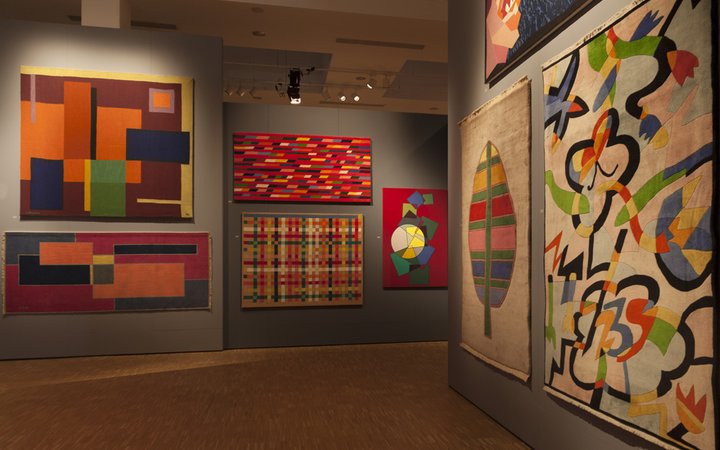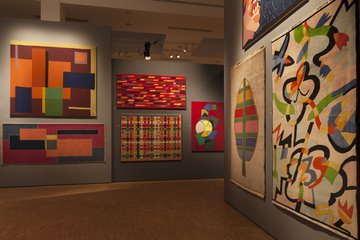107 unique textile artworks are exhibited together for the first time. The collection is constituted by unique and rare tapestries and carpets, some of them never shown before, created by the most renowned Italian manufacturers in collaboration with the greatest artists of the century (for example the Italian Futurists, Remo Salvadori, Giacomo Balla, Lucio Fontana, Mario Sironi, Renato Guttuso, Fortunato Depero, Ugo Nespolo, Ettore Sottsass, Gillo Dorfles to name a few among the many artists composing this complex scenario). The purpose of these artefacts is to visually experience the creative ferment, which permeated Italian textile art throughout the twentieth century.
A unique exhibition (12th of September – 08th of October 2017) organised, after years of research, by Moshe Tabibnia Gallery (curators Moshe Tabibnia and Virginia Giuliano) in collaboration with the Triennale di Milano, under the patronage of the City Council of Milan and the Ministry of Cultural Heritage and Activities and Tourism.
The artworks supplied by museums of contemporary art in the whole world and by private collectors provided a valuable contribution. The exhibition path reveals, for the first time, the interest of these artists for the venture on a stimulating, visually and technically original ground. A shelter for experimentation and innovation.
Moshe Tabibnia Gallery, since long time dedicated to the research and divulgation of ancient textile art, now turns towards the contemporary world with an event which seeks to trace the history, the protagonists and the fascinating aspects of textile art of the twentieth century.
The exhibition displays textile works created by Italian futurists: tapestries by Fortunato Depero and carpets by Giacomo Balla; the most important textile creations shown at the Biennale in Monza and at the Triennale in Milan; some of the tapestries produced by the Scuola di Arazzeria in Esino Lario and made on drawings by Gianni Dova, Atanasio Soldati, Alfredo Chighine, Franco Alquati, Umberto Lilloni, Giuseppe Ajmone; tapestries woven for large Italian ships. Furthermore, tapestries from the workroom of Ugo Scassa made on paintings by Corrado Cagli, Giuseppe Capogrossi, Umberto Mastroianni, Mirko Basaldella, Renato Guttuso, Emilio Tadini, Mario Sironi, Luigi Spazzapan, Renzo Piano; works of the Arazzeria Pennese made on paintings by Giacomo Balla, Afro Basaldella, Enrico Accatino, Giuseppe Capogrossi, Marcello Avenali, Diana Baylon; tapestries by MITA based on sketches by Emanuele Luzzati, Enrico Paulucci, Aldo Bosco; tapestries and carpets created by Elio Palmisano based on paintings by Oscar Kokoschka, Beppe Caturegli, Piero Dorazio, Nathalie Du Pasquier, Ugo Nespolo, Mario Radice, Mauro Reggiani, Ettore Sottsass, Gillo Dorfles, George Sowden, Luigi Veronesi, Gianfranco Ferroni, Tihamer Gyarmathy. Of course, tapestries and carpets by the main Sardinian manufacturers, tapestries embroidered by Niki Berlinguer based on the works by Corrado Cagli, Renato Guttuso, Lucio Fontana, Enzo Brunori; as well as those by Marina Zatta, based on paintings by Renzo Vespignani, Giulio Turcato, Enrico Baj, Toti Scialoja, Emilio Tadini, Mario Nigro.
To conclude with an overview of the works by some of the main protagonists characterising Italian Fiber Art from the ‘70s, such as Paola Besana, Paola Bonfante and Marialuisa Sponga.


